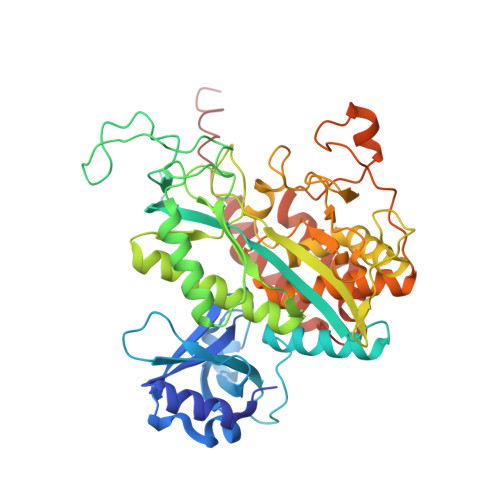Structural Basis for the Inhibition of Mycobacterium Tuberculosis Glutamine Synthetase by Novel ATP-Competitive Inhibitors.
Nilsson, M.T., Krajewski, W.W., Yellagunda, S., Prabhumurthy, S., Chamarahally, G.N., Siddamadappa, C., Srinivasa, B.R., Yahiaoui, S., Larhed, M., Karlen, A., Jones, T.A., Mowbray, S.L.(2009) J Mol Biology 393: 504
- PubMed: 19695264
- DOI: https://doi.org/10.1016/j.jmb.2009.08.028
- Primary Citation of Related Structures:
2WGS, 2WHI - PubMed Abstract:
Glutamine synthetase (GS, EC 6.3.1.2; also known as gamma-glutamyl:ammonia ligase) catalyzes the ATP-dependent condensation of glutamate and ammonia to form glutamine. The enzyme has essential roles in different tissues and species, which have led to its consideration as a drug or an herbicide target. In this article, we describe studies aimed at the discovery of new antimicrobial agents targeting Mycobacterium tuberculosis, the causative pathogen of tuberculosis. A number of distinct classes of GS inhibitors with an IC(50) of micromolar value or better were identified via high-throughput screening. A commercially available purine analogue similar to one of the clusters identified (the diketopurines), 1-[(3,4-dichlorophenyl)methyl]-3,7-dimethyl-8-morpholin-4-yl-purine-2,6-dione, was also shown to inhibit the enzyme, with a measured IC(50) of 2.5+/-0.4 microM. Two X-ray structures are presented: one is a complex of the enzyme with the purine analogue alone (2.55-A resolution), and the other includes the compound together with methionine sulfoximine phosphate, magnesium and phosphate (2.2-A resolution). The former represents a relaxed, inactive conformation of the enzyme, while the latter is a taut, active one. These structures show that the compound binds at the same position in the nucleotide site, regardless of the conformational state. The ATP-binding site of the human enzyme differs substantially, explaining why it has an approximately 60-fold lower affinity for this compound than the bacterial GS. As part of this work, we devised a new synthetic procedure for generating l-(SR)-methionine sulfoximine phosphate from l-(SR)-methionine sulfoximine, which will facilitate future investigations of novel GS inhibitors.
Organizational Affiliation:
Department of Cell and Molecular Biology, Uppsala University, Biomedical Center, Sweden.

























